
Presidential elections were held in the United States on November 6, 1860. The Republican Party ticket of Abraham Lincoln and Hannibal Hamlin won a national popular plurality, a popular majority in the North where states had already abolished slavery, and a national electoral majority comprising only Northern electoral votes. Lincoln's election thus served as the main catalyst of the states that would become the Confederacy seceding from the Union. This marked the first time that a Republican was elected president. It was also the first presidential election in which both major party candidates were registered in the same home state; the others have been in 1904, 1920, 1940, 1944, and 2016. Lincoln's 39.7% of the popular vote is to date the lowest for any winner not decided by a contingent election.
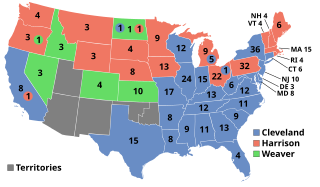
Presidential elections were held in the United States on November 8, 1892. In the fourth rematch in American history, the Democratic nominee, former president Grover Cleveland, defeated the incumbent Republican President Benjamin Harrison. Cleveland's victory made him the first president in American history to be elected to a non-consecutive second term, a feat not repeated until Donald Trump was elected in 2024. The 1892 election saw the incumbent White House party defeated in three consecutive elections, which did not occur again until 2024.
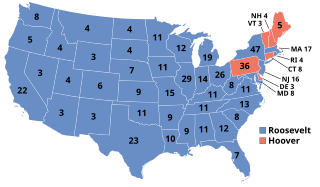
Presidential elections were held in the United States on November 8, 1932. Against the backdrop of the Great Depression, incumbent Republican President Herbert Hoover was defeated in a landslide by Democrat Franklin D. Roosevelt, the governor of New York and the vice presidential nominee of the 1920 presidential election. The election marked the effective end of the Fourth Party System, which had been dominated by Republicans, and it was the first time since 1916 that a Democrat was elected president.

Hiram Warren Johnson was an American attorney and politician who served as the 23rd governor of California from 1911 to 1917 and represented California in the U.S. Senate for five terms from 1917 to 1945. Johnson achieved national prominence in the early 20th century as a leading progressive and ran for vice president on Theodore Roosevelt's Progressive ticket in the 1912 presidential election. As a U.S. senator, Johnson was a leading critic of the foreign policy of both Woodrow Wilson and Franklin D. Roosevelt.

Edmund Gerald "Pat" Brown was an American lawyer and politician who served as the 32nd governor of California from 1959 to 1967. His first elected office was as district attorney for San Francisco, and he was later elected attorney general of California in 1950, before becoming the state's governor after the 1958 election.

James Herbert Budd was an American lawyer and Democratic politician. Involved in federal and state politics, Budd was a member of the U.S. House of Representatives for the 2nd California district from 1883 to 1885, and served as the 19th governor of California from 1895 until 1899.

James Norris Gillett was an American lawyer and politician. A Republican involved in federal and state politics, Gillett was elected both a member of the U.S. House of Representatives from California from March 4, 1903, to November 4, 1906, and as the 22nd governor of California from January 9, 1907, to January 3, 1911.
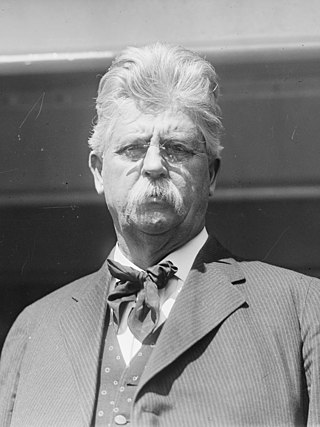
Henry Tifft Gage was an American lawyer, politician and diplomat. A Republican, Gage was elected to a single term as the 20th governor of California from 1899 to 1903. Gage was also the U.S. Minister to Portugal for several months in 1910.

George Cooper Pardee was an American doctor of medicine and Republican politician. As the 21st Governor of California, holding office from January 7, 1903, to January 9, 1907, Pardee was the second native-born Californian to assume the governorship, after Romualdo Pacheco, and the first governor born in California after statehood.
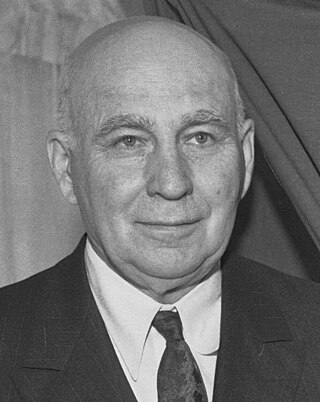
Frank Finley Merriam was an American Republican politician who served as the 28th governor of California from June 2, 1934, until January 2, 1939. Assuming the governorship at the height of the Great Depression following the death of Governor James Rolph, Merriam defeated Democratic nominee Upton Sinclair in the 1934 election. Merriam also served as the State Auditor of Iowa from 1900 to 1903, and served in both the Iowa and California state legislatures.
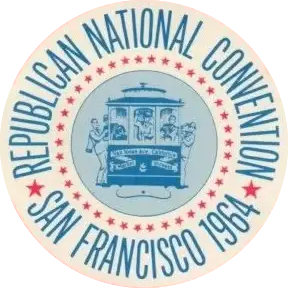
The 1964 Republican National Convention took place in the Cow Palace, Daly City, California, from July 13 to July 16, 1964. Before 1964, there had been only one national Republican convention on the West Coast, the 1956 Republican National Convention, which also took place in the Cow Palace. Many believed that a convention in San Francisco indicated the rising power of the Republican Party in the west.

The 1984 Democratic National Convention was held at the Moscone Center in San Francisco, California from July 16 to July 19, 1984, to select candidates for the 1984 United States presidential election. Former Vice President Walter Mondale was nominated for president and Representative Geraldine Ferraro of New York was nominated for vice president. Ferraro became the first woman to be nominated by either major party for the presidency or vice presidency. In another first, the 1984 Democratic Convention was chaired by the female governor of Kentucky, Martha Layne Collins. The Democratic National Committee Chairman at the time, Charles T. Manatt, led the convention.

The 1914 California gubernatorial election was held on November 3, 1914. The election saw Hiram Johnson re-elected in 1914 as governor of California on the Progressive Party ticket, nearly tripling his vote total from the 1910 California gubernatorial election.

The 1910 California gubernatorial election was held on November 8, 1910. It saw Republican Hiram Johnson elected as the state's governor. Johnson won the election with 45.9% of the popular vote, and became the 23rd governor of California. This was the first gubernatorial election in which Fresno County, Modoc County, San Benito County, Stanislaus County, and Tulare County voted for a Republican candidate. These Republican flips of traditionally Democratic counties foreshadowed the future Republican dominance of California gubernatorial elections that began in the next election.

The 1906 California gubernatorial election was held on November 6, 1906. James Gillet won the 1906 election and became the governor of California. This was the first election in which more votes were cast in Los Angeles County than in San Francisco, possibly as a result of the earthquake seven months earlier in San Francisco.

Frank Henry Kerrigan was a United States district judge of the United States District Court for the Northern District of California. He also served for nearly 30 years as a California state court judge, and was an associate justice of the California Supreme Court from January 8, 1923, to February 11, 1924.

The San Francisco plague of 1900–1904 was an epidemic of bubonic plague centered on San Francisco's Chinatown. It was the first plague epidemic in the continental United States. The epidemic was recognized by medical authorities in March 1900, but its existence was denied for more than two years by California's Republican governor Henry Gage. His denial was based on business reasons, to protect the reputations of San Francisco and California and to prevent the loss of revenue due to quarantine. The failure to act quickly may have allowed the disease to establish itself among local animal populations. Federal authorities worked to prove that there was a major health problem, and they isolated the affected area; this undermined Gage's credibility, and he lost the governorship in the 1902 elections. The new governor, George Pardee, implemented public-health measures and the epidemic was stopped in 1904. There were 121 cases identified, resulting in 119 deaths.

Two 2024 United States Senate elections in California were held on November 5, 2024, to elect a member of the United States Senate to represent the state of California. There were two ballot items for the same Class 1 seat: a special election to fill the seat for the final month of the 118th United States Congress, and a regular general election for a full term that starts on January 3, 2025, starting in the 119th United States Congress. This was the second time in a row that both a regular and special election for the U.S. Senate occurred simultaneously in California, following the 2022 elections.

On July 22, 1916, Progressive William Stephens, a U.S. Representative in California's 10th congressional district, resigned to become Lieutenant Governor of California, an appointment he accepted after former Lieutenant Governor John M. Eshleman died in office. To fill the vacancy created by Stephens' resignation, a special election was held for the remainder of the term. It was scheduled for November 7, 1916, the same day as the general election for the full term beginning March 4, 1917.

The 1902 Michigan gubernatorial election was held on November 4, 1902. Incumbent Republican Aaron T. Bliss defeated Democratic candidate Lorenzo T. Durand with 52.52% of the vote.























